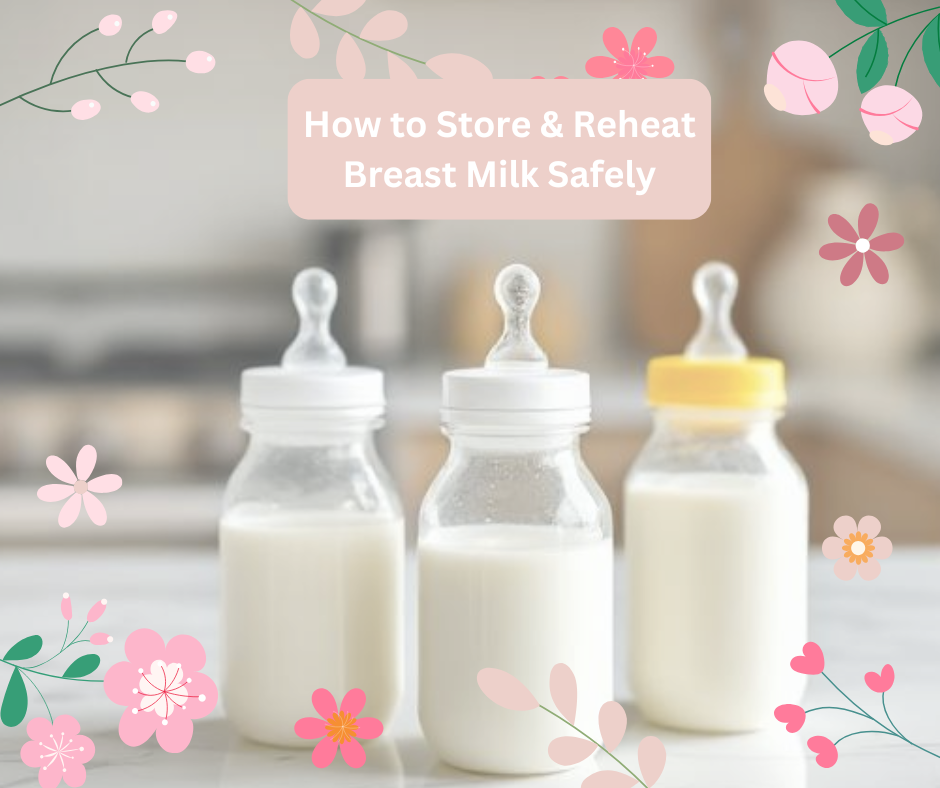
How to Store & Reheat Breast Milk Safely
Share
There’s something almost magical about breast milk.
I remember sitting in the dark at 3 a.m., pumping with one hand and scrolling through baby sleep blogs with the other, thinking, “This is literally liquid gold… and I have no idea if I’m storing it right.”
If you’re navigating the fog of new motherhood and trying to figure out what’s safe, what’s not, and how not to waste a single drop, I see you.
You’re already doing so much. This part doesn’t have to be confusing.
Let’s walk through the safest ways to store and reheat breast milk, step by step — so you can protect your baby and your peace of mind. 💕
🍼 How to Store Breast Milk Safely
🧼 1. Use Clean, Baby-Safe Containers
Always store breast milk in:
Glass bottles (sanitized + BPA-free)
BPA-free plastic bottles
Breast milk storage bags made specifically for freezing
Pro tip: Avoid any mystery containers — breast milk deserves a safe, sterile home.
🏷️ 2. Label Everything (Your Future Self Will Thank You)
Each container should have:
The date the milk was pumped
The time (if you’re juggling multiple feedings)
Fresh milk has a shelf life — and clear labels make rotation and tracking easier.
⏱️ 3. Room Temperature Guidelines
Freshly pumped milk can sit at room temperature (up to 77°F / 25°C) for up to 4 hours
After 4 hours? Discard it. I know—it hurts. But safety comes first.
❄️ 4. Refrigerator Storage (When You’ll Use It Soon)
Store milk in the back of the fridge (coldest spot)
Safe for up to 4 days
Try not to keep it on the door (temperature fluctuates too much there)
🧊 5. Freezer Storage (For Your Future Sleep-Deprived Self)
Freeze if you won’t use milk within 4 days
Best within 6 months, but still safe up to 12 months
Always leave a little space at the top of bags — breast milk expands when frozen!
🔥 Reheating Breast Milk: Do’s and Don’ts for Safety & Nutrition
❌ Never Microwave
Microwaves can create uneven heat (a.k.a. dangerous hot spots) and destroy vital nutrients. Just say no.
🌡️ Use a Warm Water Bath
Place the sealed bottle or bag in a bowl of warm water for 5–10 minutes
Gently swirl to even out the temperature
Test a drop on your wrist before feeding
Simple, safe, and no equipment needed.
🔌 Or Use a Bottle Warmer
If you prefer tech, a bottle warmer gives consistent, gentle heat.
Just make sure to follow the manufacturer’s instructions (some warm faster than others!).
🗑️ Don’t Reheat Twice
Once milk has been warmed, use it within 1 hour
If baby doesn’t finish the bottle, discard the rest
(Yes, even the precious kind you pumped at 2 a.m. — I’ve cried over this too.)
🌿 On-the-Go Storage & Reheating Tips for Moms in Motion
Because babies don’t care where you are when they get hungry 🙃
Pre-fill storage bags before heading out. Keep them in a cooler bag with ice packs.
Use a portable bottle warmer for safe reheating on the go (some plug into your car or work with hot water).
Pump straight into storage bags (if your pump allows it!) to skip extra steps and reduce contamination.
💕 Comfort Matters, Too — Especially When You’re Pumping
If you’re pumping or nursing daily, the last thing you need is a digging strap or a bra that makes you dread letdown.
That’s why I love the maternity bras from Bloom & Heal — they’re soft, wire-free, and made for the kind of days when your boobs are full, your hands are sticky, and your soul just wants to be held gently.
💗 When your body is working hard to nourish someone else, you deserve to feel held, too.
💬 FAQs: Storing & Reheating Breast Milk
1. How long can I keep breast milk at room temperature?
Freshly pumped milk can sit out for up to 4 hours at room temp. After that, it's no longer safe — best to refrigerate or discard.
2. Can I put warm breast milk in the fridge or freezer?
Let it cool to room temperature first before storing it in the fridge or freezer. Placing warm milk directly in the freezer can compromise safety.
3. Is it okay to combine milk from different pumping sessions?
Yes — but only if they’re both cooled to the same temperature. Never mix freshly pumped warm milk with already cold or frozen milk.
4. Can I reuse leftover breast milk?
No — once your baby has started drinking from a bottle, any unfinished milk should be used within 1 hour. After that, discard it to avoid bacteria growth.
5. How do I know if frozen breast milk is bad?
Spoiled milk may smell soapy, sour, or rancid. If it smells off, trust your gut and toss it. Your baby deserves fresh, safe milk.
6. Why does my breast milk separate when stored?
Totally normal! Breast milk naturally separates into layers (fat rises). Just swirl it gently — never shake it aggressively, which can break down nutrients.
Mama, I know how precious every drop is.
But even more precious? Your peace of mind.
So let this be your permission slip to do your best and let that be enough.
Need more heart-led support through your postpartum journey? Visit the Bloom & Heal Maternity Blog — we're here for the spills, the doubts, and the quiet wins. 💕

















































